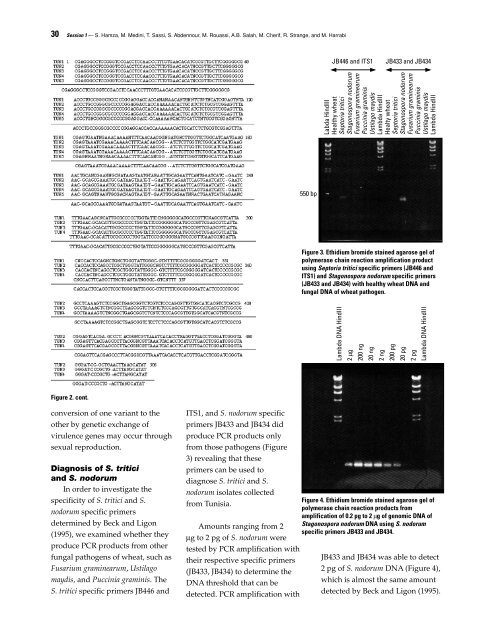Septoria and Stagonospora Diseases of Cereals - CIMMYT ...
Septoria and Stagonospora Diseases of Cereals - CIMMYT ...
Septoria and Stagonospora Diseases of Cereals - CIMMYT ...
You also want an ePaper? Increase the reach of your titles
YUMPU automatically turns print PDFs into web optimized ePapers that Google loves.
30<br />
Session 1 — S. Hamza, M. Medini, T. Sassi, S. Abdennour, M. Rouassi, A.B. Salah, M. Cherif, R. Strange, <strong>and</strong> M. Harrabi<br />
Figure 2. cont.<br />
conversion <strong>of</strong> one variant to the<br />
other by genetic exchange <strong>of</strong><br />
virulence genes may occur through<br />
sexual reproduction.<br />
Diagnosis <strong>of</strong> S. tritici<br />
<strong>and</strong> S. nodorum<br />
In order to investigate the<br />
specificity <strong>of</strong> S. tritici <strong>and</strong> S.<br />
nodorum specific primers<br />
determined by Beck <strong>and</strong> Ligon<br />
(1995), we examined whether they<br />
produce PCR products from other<br />
fungal pathogens <strong>of</strong> wheat, such as<br />
Fusarium graminearum, Ustilago<br />
maydis, <strong>and</strong> Puccinia graminis. The<br />
S. tritici specific primers JB446 <strong>and</strong><br />
ITS1, <strong>and</strong> S. nodorum specific<br />
primers JB433 <strong>and</strong> JB434 did<br />
produce PCR products only<br />
from those pathogens (Figure<br />
3) revealing that these<br />
primers can be used to<br />
diagnose S. tritici <strong>and</strong> S.<br />
nodorum isolates collected<br />
from Tunisia.<br />
Amounts ranging from 2<br />
µg to 2 pg <strong>of</strong> S. nodorum were<br />
tested by PCR amplification with<br />
their respective specific primers<br />
(JB433, JB434) to determine the<br />
DNA threshold that can be<br />
detected. PCR amplification with<br />
550 bp<br />
JB446 <strong>and</strong> ITS1 JB433 <strong>and</strong> JB434<br />
Labda HindIII<br />
Healthy wheat<br />
<strong>Septoria</strong> tritici<br />
<strong>Stagonospora</strong> nodorum<br />
Fusarium graminearum<br />
Puccinia graminis<br />
Ustilago maydis<br />
Lambda HindIII<br />
Healty wheat<br />
<strong>Septoria</strong> tritici<br />
<strong>Stagonospora</strong> nodorum<br />
Fusarium graminearum<br />
Puccinia graminis<br />
Ustilago maydis<br />
Lambda HindIII<br />
Figure 3. Ethidium bromide stained agarose gel <strong>of</strong><br />
polymerase chain reaction amplification product<br />
using <strong>Septoria</strong> tritici specific primers (JB446 <strong>and</strong><br />
ITS1) <strong>and</strong> <strong>Stagonospora</strong> nodorum specific primers<br />
(JB433 <strong>and</strong> JB434) with healthy wheat DNA <strong>and</strong><br />
fungal DNA <strong>of</strong> wheat pathogen.<br />
Lambda DNA HindIII<br />
2 µg<br />
200 ng<br />
20 ng<br />
2 ng<br />
200 pg<br />
20 pg<br />
2 pg<br />
Lambda DNA HindIII<br />
Figure 4. Ethidium bromide stained agarose gel <strong>of</strong><br />
polymerase chain reaction products from<br />
amplification <strong>of</strong> 0.2 pg to 2 µg <strong>of</strong> genomic DNA <strong>of</strong><br />
<strong>Stagonospora</strong> nodorum DNA using S. nodorum<br />
specific primers JB433 <strong>and</strong> JB434.<br />
JB433 <strong>and</strong> JB434 was able to detect<br />
2 pg <strong>of</strong> S. nodorum DNA (Figure 4),<br />
which is almost the same amount<br />
detected by Beck <strong>and</strong> Ligon (1995).









